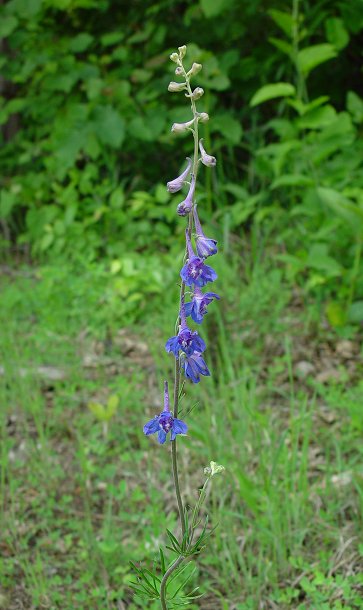Delphinium carolinianum Walter
Carolina Larkspur

Native
CC = Amb
CW = 5
MOC = 74
© DETenaglia
Delphinium carolinianum WalterCarolina Larkspur | |
 |
Native CC = Amb CW = 5 MOC = 74 |
© DETenaglia |
|
Family - Ranunculaceae Stems - Single from a small woody caudex, erect, herbaceous, terete, Variously pubescent but typically with appressed retrorse pubescence, typically simple but vigorous plant will branch, to +1m tall.
Leaves - Alternate, petiolate below, short petiolate to sessile above. Petioles to +/-15cm long, pubescent, flattened adaxially. Blades palmately divided (the main divisions divided again), to +/-9cm long and broad, pubescent. Divisions of the lowest leaves to 5mm broad. Divisions of the upper leaves linear, subacute to acute.
Inflorescence - Terminal bracteate raceme to +30cm long. Each flower subtended by at least a small subulate bract. Lower flowers with foliaceous bracts. Pedicels to 1.5cm long, typically densely retrorse pubescent. Each flower with a pair of opposite bracts at the base. Bracts subulate-linear, to 6mm long, 1mm broad, erect. Flowers - Petals 5, variously shaped, blue to white. 3 petals forming the spur of the corolla. Lateral petals bearded, deeply notched. Lateral spur petals with cylindric bases for holding nectar. Central spur petal linear and thin. Stamens many, surrounding the pistils. Filaments glabrous, greenish-white, compressed, to 6mm long, some curled, others straight. Anthers olive-greenish brown, 1.8-2mm long. Pistils 3, lanate, 5mm long in flower, tapering to the apex and a short glabrous style and stigma (to 1mm long). Sepals 5, violet blue to white, free, to 1cm long, 6-7mm broad, mostly rounded at the apex, glabrous internally, pubescent externally. Spur sepal to 2cm long, rugose.
Flowering - May - June. Habitat - Limestone glades, prairies, and rocky woods, roadsides, railroads in prairies. Origin - Native to U.S. Other info. - This showy species an be found throughout much of Missouri but is most abundant in the Ozark region of the state. The brilliant blue flowers are easy to spot growing on glades and along rocky roadsides.
Photographs taken off Hwy 106, Shannon County, MO., 5-23-03 and at Taberville Prairie, MO., 6-7-03. |